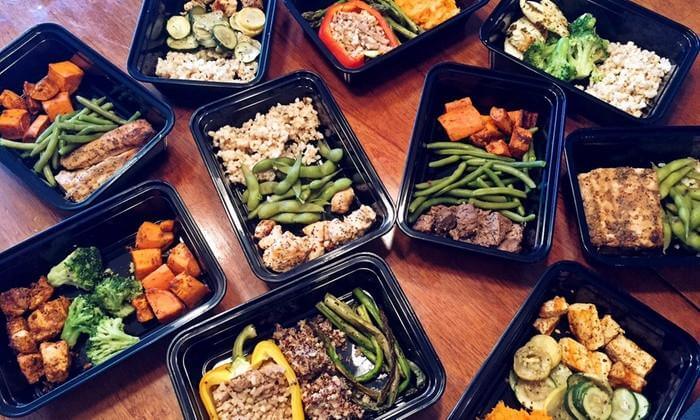5 Diet Tactics
In today’s world, dieting is more complex than ever. There are so many rules, techniques, and possibilities. Your doctor may tell you one thing, your trainer another, and then you talk to your friends and they’re doing the complete opposite, so how are you supposed to know what’s right? We feel for you and understand the frustration that ensues when trying to diet. Whether it’s for general weight loss or to look shredded for the summer, it’s not always black and white. Here we’re going to list out what’s most important for beginners to pay attention to. Often times the crazy details that people obsess over are largely unimportant to the average person.
- The most important thing you need to pay attention to are calories in vs. calories out. Again, this is on a general scale. We’ve increased calories for people and had them lose weight, but that’s not always typical. 9 out of 10 times, we’ll find that a decrease in calories will result in a decrease in weight. In order to decrease calories, you first need to be at a maintenance body-weight (where you’re not increasing weight or decreasing weight) and you’ll need to track your calories here to develop a baseline to reference off of. One thing to note is that 3500 calories equal a pound, but depending on your activity levels, it’s always smart to start off with small decreases in calorie intake instead of large jumps. 500 calories a day or 1 pound per week sounds great, but start off small (depending on your maintenance level) and go from there. It’s also important to understand that you’re undergoing a lifestyle change, and that doesn’t happen over night for most.
- This little subsection is to point out one big flaw we see with many people – customers and non-customers. When you track your calories and are progressing each day it’s important that it doesn’t stop or else your progress will. If you go from 2200 calories a day to 2000 calories a day, but go out drinking and eating a big meal out it can be largely disruptive to your diet progress. A 200 calorie deficit through 7 days is only 1400 calories, which believe it or not, is very easy to consume through alcohol and a meal out. You may even end up gaining weight because of that. While we understand the desire for balance and fun, it’s important that you keep your calories in check on a weekly scale and not just a daily scale.
- You may have heard of IIFYM (If it fits your macros) or flexible dieting that allows you to eat foods you like while still being able to diet because it really comes down to the math of hitting each macro nutrient and source matters less for these dieters. Ex. For them, 40g of carbs is 40g of carbs. Whether it comes from rice or sugar. While there is more to this, the same technique can work for beginner dieters (for overall weight loss) when looking at calories. Before we start playing with macros and nutrient timing, let’s just get the calories where they need to be. If you’re going to go out and get an 800 calorie meal once a week, make sure you calculate it before hand so you’re able to restrict your food earlier in the day to allow it.
- Now that your tracking or pre-planning your meals and caloric intake, let’s take a look at the next step of dieting… The Macro Nutrients. Macro nutrients are your nutrients that carry calories like Fat (9 cal/gram), Protein (4 cal/gram), and Carbohydrates (4 cal/gram). This is something that will vary largely for each person depending on their specific goals, size, metabolism, and previous experience but it is definitely most productive with balance. First we suggest you meet your protein goal. For simplicity, choose 1.2g of protein per lean body mass (weight after subtracting fat). Then, you can use the remaining calories as about 60% carb and 40% fat. Again, this is in it’s most basic form and just provided for guidance as one of the biggest arguments in dieting and fad diets is the proportions of macro nutrients. One thing that has always worked for those just simply looking to lose weight, is balance, so we’ll start there and once you give it some time, you can start to see changes and make adjustments accordingly.
- This step is the hardest step of them all. Don’t change too much, too fast. We know you want to look beach

ready yesterday, unfortunately you can’t undo the past 20 years of your life overnight so we’re going to take baby-steps in aiding fat loss so we can draw data from it. Once you’ve changed your diet and are starting to see how your body reacts to the food sources and calories over time, then you can look to add in things like cardio, fat-loss accelerating supplements, and different meal timing techniques. While these 3 things just mentioned are important, it makes it alarmingly difficult for a beginner to monitor the changes in their body when these are implemented along with a diet change and a macro change. The less you change at one time the better off you’ll be in the long run and if you’re reading this article, you’re in for the marathon. - Step 4 is all mental. Another thing we often see with our customers, athletes, and friends is that they rationalize their results. We hear stuff like “I’ve been so good lately, I can have this meal” or “It’s summer now, I just want to have fun”. We understand these thought patterns and throughout our time, we’ve experienced them first hand. It’s important you understand that they are lethal to your progress and it’s something you have to force yourself to stay away from. The best way to counter cannibalizing your results is to refer back to step 1 and make sure you plan for those meals and social times.
- Step 5 is our concluding step. Make it fun! Often times we hear people tell us that dieting is very difficult and that the food is awful, however it doesn’t have to be like that. Spend some time to understand quality food sources and food options that can also taste good for you to enjoy. We’ve found that most of the time, people are just blind to some of the choices they have because they’re yet to experience them. If you’re still having issues with your diet, you can always stop in a local Coalition Nutrition to chat with one of our team members.
Ready To Start?
Download the MyFitnessPal App or MyMacros+ to start tracking your food!

